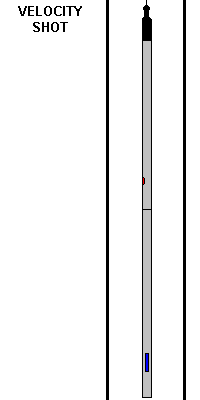

Stationary velocity shots are one of the two primary survey methods used by Cardinal while running injection profiles. Fluid velocity is measured by timing the travel of radioactive material from the ejector to the detector 5 feet away. Timing the travel period is accomplished by setting up the chart recorder in 5" time drive (5"= 1 minute or each chart division is equal to 3 seconds).
With the reaction time we are able to calculate a barrel per day rate by calculating the casing volume (4.95" I.D.), less the tool displacement (1.375" O.D.). The following is a sample calculations for the slug in our example:
| Subject | Formula | Cubic Inches | Cu. In./BBL | BBLS/5' |
|---|---|---|---|---|
| Casing | 3.14 x (4.950"/2)² x 60" = | 1,154.65 | 10,164 | .1136 |
| Tool | 3.14 x (1.375"/2)² x 60" = | 89.09 | 10,164 | .0088 |
| Net BBLS | .1048 | |||
| (86,400 secs/day / Reaction Time sec) x V bbls = BBLS/DAY |
|---|
| Slug #3 - (86,400 / 9) x .1048 = 1006.08 BBLS/DAY |
These rates give us a point to compare and calculate rate differentials throughout the wellbore in order to determine points of fluid loss and the volumes of those losses. Note: The above calculations are based on the assumption of a clean and consistent internal diameter of 4.95 inches. However, we all know that is rarely the case. Take a look at the calculations on our caliper page. I believe you will be surprised at how much error can be avoided by knowing the internal diameter and general condition of the wellbore at the time of logging.
Injection Profile Page
Cardinal Welcome Page
